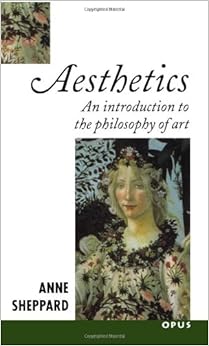
Free Downloads Aesthetics: An Introduction To The Philosophy Of Art (Oxford Paperbacks)

Why do people read novels, go to the theater, or listen to beautiful music? Do we seek out aesthetic experiences simply because we enjoy them--or is there another, deeper, reason we spend our leisure time viewing or experiencing works of art? Aesthetics, the first short introduction to the contemporary philosophy of aesthetics, examines not just the nature of the aesthetic experience, but the definition of art, and its moral and intrinsic value in our lives. Anne Sheppard divides her work into two parts: In the first, she summarizes the major theories defining art and beauty; in the second, she explores the nature of aesthetic evaluation and appreciation. As Sheppard explains, there are three main approaches to defining art, all focused on what art objects share. One proposes that all art imitates something in life, another that it expresses something (such as anger or ecstasy), still another suggests that all art has formal qualities. There is also a fourth which offers that all art shares the quality of beauty. In the second part, which concentrates on literary art, Sheppard explores such philosophic topics as critical judgment, meaning and truth in literature, and the relationship between art and morals. She raises such questions as whether there is one correct interpretation of a work of art and whether art has a moral effect on its audience and, citing specific examples, explores the views that have been put forth. A wide-ranging, intriguing book, which assumes no formal knowledge on the part of its readers, Aesthetics opens the door to a greater understanding and appreciation of art.

Series: Oxford Paperbacks
Paperback: 192 pages
Publisher: Oxford University Press; 1 edition (December 17, 1987)
Language: English
ISBN-10: 0192891642
ISBN-13: 978-0192891648
Product Dimensions: 7.8 x 0.5 x 5.1 inches
Shipping Weight: 7 ounces (View shipping rates and policies)
Average Customer Review: 4.0 out of 5 stars See all reviews (3 customer reviews)
Best Sellers Rank: #517,166 in Books (See Top 100 in Books) #131 in Books > Textbooks > Humanities > Philosophy > Aesthetics #381 in Books > Politics & Social Sciences > Philosophy > Aesthetics #2524 in Books > Arts & Photography > History & Criticism > Criticism

Check this out if you're looking for a concise and well-written introduction to the philosophy of art. The author explores why we feel art is so important, what makes 'good' art, and major ideas concerning art as introduced by other philosopher.(...) It's 154-pages, paperback, and has several b&w photos of paintings referred to in the text.
I inherited use of this text as the preferred text for the aesthetics portion of a course on Truth, Beauty, and Goodness. Since I chose Quine's "Web of Belief" and the Kenny Reader on Wittgenstein for the section on Truth, so that students can engage the contemporary issues associated with truth from an overall perspective and actually do philosophy via the extraordinarily subversive energy of Wittgenstein's questions, the Sheppard text fits perfectly as the text that frames the issues over aesthetics in a way that demonstrates the lessons learned from the first two books. This is also short enough to cover the main issues quickly so that there is time left for goodness at the end of the course!
I read "Aesthetics" when it was assigned for a graduate level course on 'Aesthetics and Critical Judgment'. I was able to read the entire book within a week since Sheppard takes care to lay out her points simply and relate them to common experience.The first half of the book contains visual art examples with black & white plates to refer to, while the second half focuses on literary and some film examples. She attempts to summarize Plato, Tolstoy, Kant, E. D. Hirsch and others' theories regarding aesthetics and judgment, so her book serves as a good overview or introduction to the philosophy of art like the subtitle suggests.Overall, I didn't find the book as interesting as reading other secondary sources on philosophy or even the primary sources. I'm glad I purchased the book Used, because neither it, nor many other 154-page paperbacks are worth the $40+ new price.
Aesthetics: An Introduction to the Philosophy of Art (Oxford Paperbacks) The Oxford Handbook of The History of Analytic Philosophy (Oxford Handbooks) An Introduction to the Philosophy of Art (Cambridge Introductions to Philosophy) Idols of Perversity: Fantasies of Feminine Evil in Fin-de-Siècle Culture (Oxford Paperbacks) The Decline of the West (Oxford Paperbacks) The Intimate Enemy: Loss and Recovery of Self Under Colonialism (Oxford India Paperbacks) Painting and Experience in Fifteenth-Century Italy: A Primer in the Social History of Pictorial Style (Oxford Paperbacks) The Poets of Tin Pan Alley: A History of America's Great Lyricists (Oxford Paperbacks) Jawaharlal Nehru: Rebel and Statesman (Oxford India Paperbacks) The Aesthetics of Power: Essays in the Critical History of Art (Cambridge Studies in New Art History and Criticism) Chinese Brushwork in Calligraphy and Painting: Its History, Aesthetics, and Techniques (Dover Fine Art, History of Art) The Lighting Art: The Aesthetics of Stage Lighting Design (2nd Edition) Art in Motion, Revised Edition: Animation Aesthetics Aesthetics of Interaction in Digital Art (MIT Press) Puzzles about Art: An Aesthetics Casebook Works of Game: On the Aesthetics of Games and Art (Playful Thinking) Philosophy's Second Revolution: Early and Recent Analytic Philosophy The Story of Analytic Philosophy: Plot and Heroes (Routledge Studies in Twentieth-Century Philosophy) Current Controversies in Experimental Philosophy (Current Controversies in Philosophy) Pink Floyd and Philosophy: Careful with that Axiom, Eugene! (Popular Culture and Philosophy)



